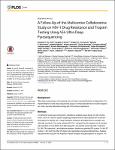A Follow-Up of the Multicenter Collaborative Study on HIV-1 Drug Resistance and Tropism Testing Using 454 Ultra Deep Pyrosequencing
John, Elizabeth P. St.
Simen, Birgitte B.
Turenchalk, Gregory S.
Braverman, Michael S.
Abbate, Isabella
Aerssens, Jeroen
Bouchez, Olivier
Gabriel, Christian
Izopet, Jacques
Meixenberger, Karolin
Giallonardo, Francesca Di
Schlapbach, Ralph
Paredes, Roger
Sakwa, James
Schmitz-Agheguian, Gudrun G.
Thielen, Alexander
Victor, Martin
Metzner, Karin J.
Däumer, Martin P.
Background: Ultra deep sequencing is of increasing use not only in research but also in diagnostics. For implementation of ultra deep sequencing assays in clinical laboratories for routine diagnostics, intra- and inter-laboratory testing are of the utmost importance. Methods: A multicenter study was conducted to validate an updated assay design for 454 Life Sciences’ GS FLX Titanium system targeting protease/reverse transcriptase (RTP) and env (V3) regions to identify HIV-1 drug-resistance mutations and determine co-receptor use with high sensitivity. The study included 30 HIV-1 subtype B and 6 subtype non-B samples with viral titers (VT) of 3,940–447,400 copies/mL, two dilution series (52,129–1,340 and 25,130–734 copies/mL), and triplicate samples. Amplicons spanning PR codons 10–99, RT codons 1–251 and the entire V3 region were generated using barcoded primers. Analysis was performed using the GS Amplicon Variant Analyzer and geno2pheno for tropism. For comparison, population sequencing was performed using the ViroSeq HIV-1 genotyping system. Results: The median sequencing depth across the 11 sites was 1,829 reads per position for RTP (IQR 592–3,488) and 2,410 for V3 (IQR 786–3,695). 10 preselected drug resistant variants were measured across sites and showed high inter-laboratory correlation across all sites with data (P20% were missed, variants 2–10% were detected at most sites (even at low VT), and variants 1–2% were detected by some sites. All mutations detected by population sequencing were also detected by UDS. Conclusions: This assay design results in an accurate and reproducible approach to analyze HIV-1 mutant spectra, even at variant frequencies well below those routinely detectable by population sequencing.
Dateien zu dieser Publikation
Keine Lizenzangabe
Verwandte Publikationen
Anzeige der Publikationen mit ähnlichem Titel, Autor, Urheber und Thema.
-
2007-05-25ZeitschriftenartikelFepA- and TonB-dependent bacteriophage H8: receptor binding and genomic sequence. Rabsch, Wolfgang; Ma, Li; Wiley, Graham; Najar, Fares Z.; Kaserer, Wallace; Schuerch, Daniel W.; Klebba, Joseph E.; Roe, Bruce A.; Gomez, Jenny A. Laverde; Schallmey, Marcus; Newton, Salete M. C.; Klebba, Phillip E.H8 is derived from a collection of Salmonella enterica serotype Enteritidis bacteriophage. Its morphology and genomic structure closely resemble those of bacteriophage T5 in the family Siphoviridae. H8 infected S. enterica ...
-
2005-06-20ZeitschriftenartikelViral promoters can initiate expression of toxin genes introduced into Escherichia coli Lewin, Astrid; Mayer, Martin; Chusainow, Janet; Jacob, Daniela; Appel, BerndBackground: The expression of recombinant proteins in eukaryotic cells requires the fusion of the coding region to a promoter functional in the eukaryotic cell line. Viral promoters are very often used for this purpose. ...
-
2013-08-08ZeitschriftenartikelCytomegalovirus Downregulates IRE1 to Repress the Unfolded Protein Response Stahl, Sebastian; Burkhart, Julia M.; Hinte, Florian; Tirosh, Boaz; Mohr, Hermine; Zahedi, René P.; Sickmann, Albert; Ruzsics, Zsolt; Budt, Matthias; Brune, WolframDuring viral infection, a massive demand for viral glycoproteins can overwhelm the capacity of the protein folding and quality control machinery, leading to an accumulation of unfolded proteins in the endoplasmic reticulum ...

